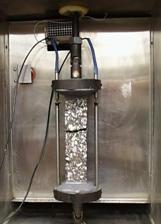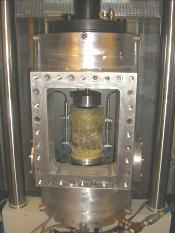|
University of Nevada-Reno |
|
The research team of the University of Nevada, Reno (UNR) is led by Professor Peter E. Sebaaly from the Department of Civil and Environmental Engineering. The UNR team also includes Drs. Elie Hajj, Raj Siddharthan, and George Fernandez, Mr. Haissam Sebaaly and several graduate students. Joining the UNR team as consultants are Drs. Claine Petersen, Charles Glover, Adam Hand, and Jon Epps. The UNR team has extensive experience in fundamental and applied research, outreach, technology transfer and training activities. The UNR team has been conducting research in the areas of moisture damage, rutting, and thermal cracking of hot mix asphalt mixtures for over twenty-five years. In addition, the UNR team has strong knowledge in the mechanical modeling of flexible pavements and the development of mechanistic pavement design procedures for new and rehabilitated pavements. Recycled Asphalt Materials The UNR team will develop a method to evaluate RAP materials (binder and aggregate) that avoids the need for extraction and recovery. UNR will also assess the effect of high RAP content on HMA mixtures and develop a mix design for HMA mixtures that contains a high percentage of RAP materials. Thermal Cracking The UNR team will develop models that predict aging and thermal stresses in HMA mixtures in the intermountain region, as well as develop a practical method to evaluate the resistance of HMA mixtures to thermal cracking. HMA Mixtures for Critical Conditions The UNR team will define the critical conditions of HMA mixtures in terms of temperature and rate of loading, develop a practical test to assess the behavior of HMA mixtures under critical conditions, and assess the effects of mixture components on HMA behavior under critical conditions. Validation UNR will work with the state DOTs to design and construct HMA pavements following the AASHTO Mechanistic-Empirical Pavement Design Guide (MEPDG). Using data from the design of the MEPDG sections, UNR will further develop the Guide’s polymer modified binder and aging models. Finally, UNR will use the performance of the MEPDG sections as a means to validate the models developed in the Consortium research. Technology Transfer The University of Nevada-Reno takes the lead on technology transfer and communications. This group will develop and maintain materials and research databases. They maintain the Consortium website and publish the newsletter. Also, they will be developing training materials and presenting workshops and seminars. |
|
The Thermal Stress Restrained Specimen Test (TSRST) will be modified and used in Consortium research on the thermal cracking of HMA mixtures
Photo courtesy University of Nevada-Reno.
|

|
The University of Wisconsin brings together a diverse and experienced team to conduct research with the Asphalt Research Consortium. The UW effort is centered at the Madison campus, where 16 individuals and a technical communications consulting firm are engaged in ARC activities. The team includes two faculty members, four research staff members, six graduate students and four undergraduates. Two faculty members at other UW system campuses are also involved in the effort. Engineered Materials The UW team plays a lead role in the area of engineered materials, with research focused on enhanced performance and resource conservation. Guiding principles are that engineering asphalt binders can reduce the risk of pavement failures due to traffic and climate, and engineered asphalts can conserve resources both by reducing energy for construction and by increasing the use of recycled materials. The team will pursue improved methods to characterize binder resistance to rutting using nonlinear viscoelasticity and binder damage resistance characterization. They will also develop improved methods to quantify thermo-volumetric properties to improve resistance to thermal cracking. The methods will advance knowledge of how to select modifiers to improve binder damage resistance under realistic field conditions. The team has developed detailed plans to advance understanding of warm mix and cold mix additives. They will also join other ARC partners to develop improved methods to characterize binders in recycled asphalt pavements and to estimate the binder grade changes needed when high percentages of recycled asphalt pavement (RAP) are used in mix designs. Moisture Damage As its main goal in the area of moisture damage, the UW team identified the need to develop simple and reliable methods to measure cohesion and adhesion of asphalt binders. Using the pneumatic pull-off test and the dynamic shear rheometer test as its main techniques, the team will build on previous work to redesign hardware and develop testing protocols that can directly and effectively measure bond strength of binders to mineral surfaces. Fatigue Damage The UW team will seek to develop a reliable test to explain the role of binders in the fatigue of mixtures and pavements. Building on work it has pioneered since 2000, the team has a major goal to find a surrogate test using current dynamic shear rheometers. Beyond developing this test methodology, another major goal is to understand how modifiers can improve the fatigue life of binders. The team has a comprehensive plan to test various fatigue models for asphalts. It will select those models that can be implemented effectively to provide better fatigue life of pavements under various simulated conditions of traffic, climate and pavement structures. |
|
University of Wisconsin-Madison |
|
Modifying the dynamic shear rheometer to measure cohesion and adhesion of asphalt-aggregate systems is essential for understanding moisture damage and reducing the risk of pavement failures caused by moisture effects. Photo courtesy University of Wisconsin-Madison. |

|
Dr. Hussain Bahia serves as principal investigator for UW-Madison’s participation in the Asphalt Research Consortium. Dr. Wen supervises many day-to-day technical and operational activities. Dr. Daranga is responsible for overseeing UW’s ARC laboratory facilities. Mr. Hanz handles ARC-related contracting and personnel issues. |
|
Advanced Asphalt Technologies, LLC |
|
Advanced Asphalt Technologies, LLC (AAT) is a small engineering company in Sterling, Virginia, that specializes in providing engineering and testing services to the asphalt paving industry. AAT was started in 1993 to provide commercial application of the asphalt research products from the Strategic Highway Research Program (SHRP). The staff of AAT is committed to using the latest and best technologies in the design and construction of flexible paving materials and pavement structures. Dr. Ramon Bonaquist, P.E., will coordinate AAT’s activities. Dr. Donald Christensen, P.E. will lead several of AAT’s tasks. Laboratory work at AAT will be under the direction of Mr. Donald Jack. AAT will have an applications-oriented role in the Asphalt Research Consortium, working primarily within the engineered materials, validation, technology development, and technology transfer program areas. AAT will be working on two tasks in the engineered materials program area. The first is the improvement of models relating engineering properties of asphalt concrete to mixture composition. As performance models become more routinely used in pavement design and analysis, mixture designers will be faced with designing mixtures to meet specific engineering properties. Few mixture designers have experience with this design situation. Models relating engineering properties to mixture composition can be used by pavement design engineers to obtain material properties for pavement analysis. They can also be used by mix designers in the preparation of job mix formulas for mixtures with specific engineering properties. The second task AAT will work on in the Engineered Materials program area is to provide support to the University Nevada-Reno research team in the RAP study that will ultimately produce an improved design procedure for mixtures incorporating RAP. |
|
To remove your name from our mailing list, please click here. Questions or comments? E-mail us at psebaaly@unr.edu or call 775-784-6565. |

|
The Repeated Load Triaxial test (RLT) will be used in the research on the design of HMA mixtures with improved resistance to rutting. |